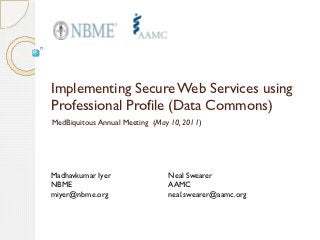
Implementing secure Web services using Professional Profile
- 1. Implementing Secure Web Services using Professional Profile (Data Commons) MedBiquitous Annual Meeting (May 10, 2011) Madhavkumar Iyer Neal Swearer NBME AAMC miyer@nbme.org neal.swearer@aamc.org
- 2. What is Data Commons? An infrastructure for real-time creation of data sets across organizations in the House of Medicine based on agreements. Developed jointly by NBME & AAMC. Not a new repository. Data sets compiled from existing repositories and expunged after creation. Organizational members build infrastructure collaboratively and own and operate it jointly. Used to aggregate data sets for individuals, educational programs, institutions and educational research. Individual medical professional can compile data for private self-assessment or to authorize public report-out of selected information.
- 3. Definitions Data Sharing Agreement Agreement between participating organizations for the exchange for data in real-time. Provider A participating organization providing data to Data Commons Invoker A participating organization requesting data from Data Commons IDMS Identity Matching Service to match or reconcile different identifiers used across multiple organizations for each medical professional.
- 4. System Architecture Click to edit Master text styles ◦ Second level ◦ Third level Fourth level Fifth level
- 5. System Features Connects to certified Data Providers Accepts requests only from member organizations Requests are authenticated & authorized before retrieving data Request/Response data is encrypted based on invoker’s 128 bit KEY Requests validated using Authorization Certificate Transactions logged without storing request/response data Generic Web Service processes all requests from Invokers Providers provide data using Web Services All Web Services are of document/literal format and secured by SSL Generic Request/Response XML data formats for Invoker/Provider
- 6. Technology Application Server – J2EE 1.4 Oracle Database 10g/11g Java / PL-SQL XML SOAP 1.1 WSDL 2.0 AES 128 bit message encryption
- 7. Using MedBiquitous Professional Profile The following operations uses MedBiquitous Professional Profile: ◦ Get Enrolled Students ◦ NBME gets updated enrolled student information for each school from AAMC ◦ Get Matriculated Students ◦ NBME gets new matriculants for each school from AAMC ◦ IDMS Biographic Update ◦ NBME and AAMC provide updates to IDMS
- 8. MedBiquitous Professional Profile - Sample
- 9. MedBiquitous XML Schemas The MedBiquitous Healthcare Professional Profile Schema provides a data structure that allows one to represent one or more healthcare professionals in a standard format. DataCommons uses version 1.0 of the following MedBiquitous XML schemas: ◦ Member ◦ Name ◦ Address Source: http://ns.medbiq.org/member/v1/
- 10. Example 1: Using the MedBiquitous XML Schemas GetStudentProfile web service operation ◦ Request <DcomOutboundGetStudentProfileRequest xmlns="http://www.dcom.org/service"> <OperationName>GetStudentProfile</OperationName> <RequestPacket> <RequestHeader> <AamcId>12113983</AamcId> <MedicalSchoolCode>816</MedicalSchoolCode> </RequestHeader> </RequestPacket> <TransactionId>112312312318</TransactionId> </DcomOutboundGetStudentProfileRequest>
- 11. Example 1: Using the MedBiquitous XML Schemas GetStudentProfile web service operation (continued) ◦ Response <DcomOutboundGetStudentProfileResponse xmlns="http://www.dcom.org/service/getStudentProfile" xmlns:dcom=http://www.dcom.org/service xmlns:medAddress="http://ns.medbiq.org/address/v1/" xmlns:medMember="http://ns.medbiq.org/member/v1/" xmlns:medName="http://ns.medbiq.org/name/v1/"> …. </DcomOutboundGetStudentProfileResponse>
- 12. Example 1: Using the MedBiquitous XML Schemas GetStudentProfile web service operation (continued) ◦ Response <medMember:Members> <medMember:Member restrictions="Restricted"> <medMember:UniqueID domain="Member:USMLE ID">52153983</medMember:UniqueID> <medMember:UniqueID domain="Member:AAMC ID">12713993</medMember:UniqueID> … </medMember:Member> </medMember:Members>
- 13. Questions?
Editor's Notes
- 10/22/12
- The Member schema is dependent on the Name and Address schemas. 10/22/12
- The request does not use the MedBiquitous XML Professional Profile. 10/22/12
- The response uses a combination of MedBiquitous XML Professional Profile and custom schemas. 10/22/12
- Notice the additional information being captured in the UniqueID “domain” attribute. 10/22/12
